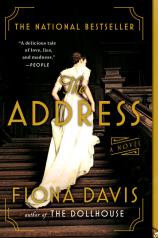Author Talk: August 8, 2017
In her debut novel, THE DOLLHOUSE, Fiona Davis pulled readers into the lush world of New York City's glamorous Barbizon Hotel for Women. For her follow-up, THE ADDRESS, the setting shifts to another iconic New York building, The Dakota, one of the first apartment houses to be built on the Upper West Side. In this interview, Davis talks about her inspiration for her second novel, how she chose the story’s two timelines (the 1880s and the 1980s), the research she conducted, and the ways in which she seamlessly blended fact and fiction.
Question: What was the inspiration for THE ADDRESS?
Fiona Davis: Once I’d finished work on THE DOLLHOUSE, I knew I wanted to set another book in an iconic New York building. One day I emerged from the subway at 72nd Street and looked up at the Dakota, a building I pass at least once a week, and realized I had my answer. The Dakota has a long history, and, like the Barbizon Hotel for Women, was unusual for its time, as it was one of the first apartment houses to be built on the Upper West Side.
When the Dakota was constructed in the 1880s by architect Henry Hardenbergh and owner Edward Clark, the rest of the neighborhood was undeveloped, marked with pig sties and farmland. The decision to build was risky on two fronts. First, that area of Manhattan was considered unfashionable by the wealthy clientele they hoped to attract. Also, the majority of the upper-crust families preferred to live in brownstones. The very idea of sharing a building with others was considered on par with living in a tenement, and simply not done. Yet Hardenbergh and Clark had the foresight to see that the rocky, uneven land far north of the city proper was in fact a gold mine.
They designed a building that offered luxurious living loaded with amenities: a dining room, laundry, barber shop, tailor, even a bakery, and it was a smashing success. Over the years, stars drawn to the building’s high ceilings, enormous rooms and proximity to Central Park include Leonard Bernstein, John Lennon and Yoko Ono, Rudolf Nureyev, Lauren Bacall, Roberta Flack, Harlan Coben, Paul Goldberger, Jason Robards and Gilda Radner. The foresight of Clark and Hardenbergh was uncanny.
Q: How did you choose the timelines in the book?
FD: I decided to set part of the novel in 1884, the year the Dakota opened, when the Gilded Age was in full swing, as well as a parallel story set in 1985. The mid-1980s interested me because I’d first arrived in the city around then, when the Dakota was blackened with centuries of soot and the neighborhood was dicey. But New York City had finally pulled out of near-bankruptcy, and clubs like The Limelight and restaurants like The Odeon were attracting a crowd that liked to party hard. It was a Gilded Age of its own, much like that of the 1880s. Since I happened to be renovating my own apartment while writing the book, I made the heroine in the 1980s time line an interior decorator, in charge of stripping one of the Dakota apartments of its mahogany crown molding and carved marble mantelpieces and replacing them with shag carpets and mirrored walls. I enjoyed exploring the ways the building and the city changed over the century, as well as the ways they remained the same, and the Dakota’s remarkable impact on the people who lived and worked there.
Q: What are some of the inspirations for the other locations in the novel?
FD: I based the interior of a grand mansion’s library on the East Room of the Morgan Library & Museum, the former home of American financier J.P. Morgan. On the opposite end of the income spectrum, I was inspired by a visit to the Tenement Museum, where immigrant apartments have been carefully restored and is now open to the public. Blackwell’s Island, which is now known as Roosevelt Island and is easily reachable by tram, once housed an insane asylum, hospital, penitentiary, alms house, workhouse and lunatic asylum, and a few of the original structures still remain. Today, the asylum’s octagonal tower has been integrated into a modern apartment building, a fascinating juxtaposition.
Q: What kind of research did you do for the book?
FD: I was inspired by Goethe’s famous quote: “Music is liquid architecture; architecture is frozen music,” and interviews with designers, architects and historians helped round out my research. I also visited various apartments in the Dakota, including the former home of Lauren Bacall, and was lucky enough to get a full tour of the building, including the basement and the upper floors, where former maid’s rooms now go for a princely sum.
DNA testing takes a prominent role in the plot, and several experts in the field answered my questions and helped me figure out the Camden family tree. I was fascinated by the discovery of Richard III’s bones under a parking lot in England in 2012, and the fact that scientists were able to link the bones to living relatives 527 years after his death using a specific kind of DNA test.
A number of books provided inspiration as well, including Stephen Birmingham’s LIFE AT THE DAKOTA; Andrew Alpern’s THE DAKOTA: A History of the World’s Best-Known Apartment Building; Elizabeth Hawes’ NEW YORK, NEW YORK: How the Apartment House Transformed the Life of the City; TED DAYS IN A MAD-HOUSE by Nellie Bly; and Tessa Boase’s THE HOUSEKEEPER’S TALE: The Women Who Really Ran the English Country House.
Q: What are some of the ways you’ve blended fact and fiction?
FD: In an early issue of The New York Times, I discovered that in June of 1885 a big boat parade heralded the arrival of the Statue of Liberty from France. That’s the fact part. For purposes of the plot, I have it arriving in fall of that year. Nellie Bly makes an appearance in THE ADDRESS two years before she actually went undercover at Blackwell’s Island Insane Asylum. She was far too colorful a figure to pass up, and I wanted to acknowledge her intrepid journalism. Astute Gilded Age fans may catch that the Rutherford’s mansion is quite similar to that of the Vanderbilt’s, which used to stand on Fifth Avenue, while avid architects/historians will notice that the speech one of my characters makes is drawn from Edward Clark’s 1879 speech to the West End Association. Almost all of the residents named in the 1880s section of THE ADDRESS were drawn from tenant lists from the year it opened, as it attracted some of the more colorful characters of New York high society.
My hope is that THE ADDRESS offers an inside look at a remarkable building, one that has been home to both joy and tragedy over a century.








